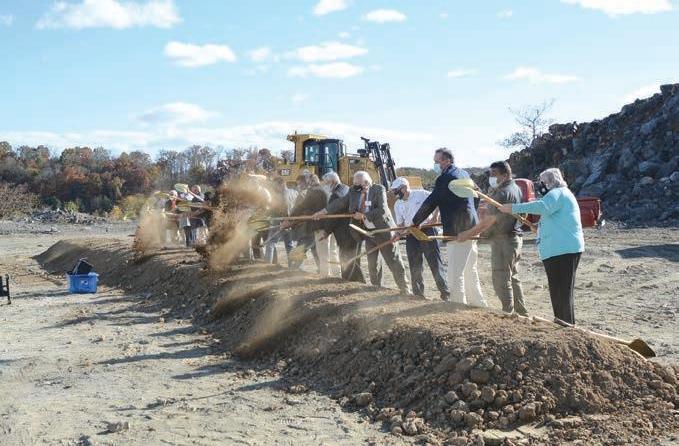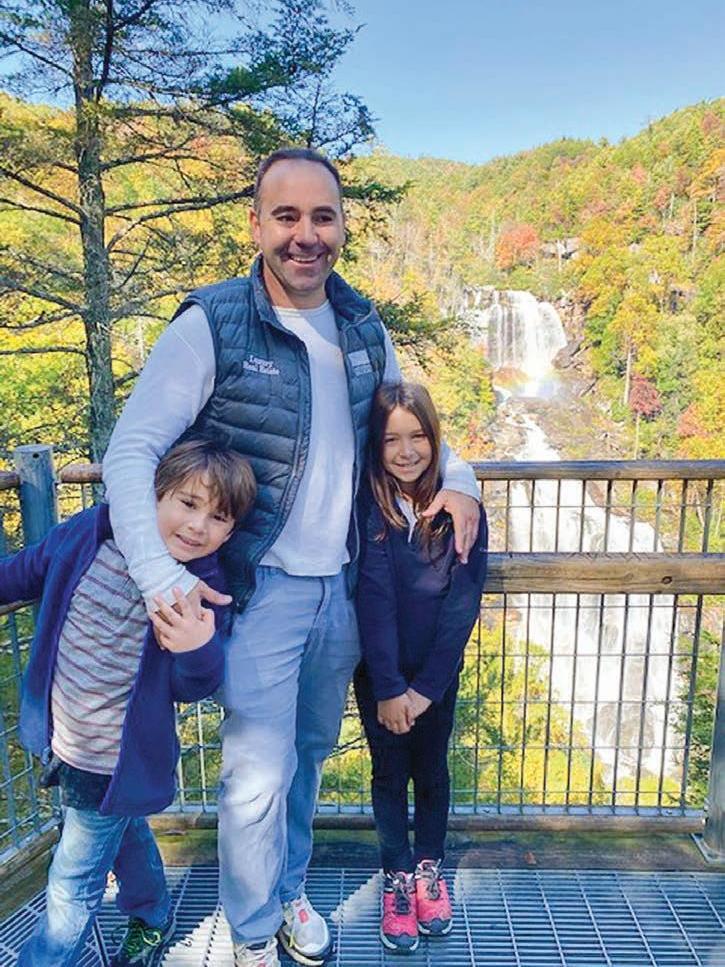
27 minute read
News
The newly unveiled vision for a road trip themed development along Interstate 40 in Sevierville is expected to welcome visitors starting in 2022. Donated rendering
Tribe breaks ground on Sevier County development
BY HOLLY KAYS STAFF WRITER
The first phase of a development effort worth tens of millions of dollars is expected to open in 2022 following the Eastern Band of Cherokee Indians’ Nov. 10 groundbreaking at the 200-acre site it purchased along Interstate 40 in Tennessee last year.
Including about 60 acres and currently referred to as the Roadside District, the section will be developed around the theme of the classic American road trip, including both nostalgic and modern elements of that tradition.
“We have the opportunity to build on many of the staples that are commonly known as the Great American Road Trip,” said Kituwah LLC CEO Mark Hubble during the groundbreaking ceremony. “The gas stations of old typically might have had two or four pumps. Our gigantic travel center will have over 100, and will be over 60,000 square feet. The diners often featured hamburgers, fried chicken, fries and other staples. We will offer these classic foods and many more through unique experiential dining. Landmarks became defining moments for many of the children. Ours will have both replicas of recognizable classics and unique one-of-a-kind, interactive icons for photos and lifetime memories.”
ROAD TO THE ROAD TRIP
Tribal Council approved $13.5 million to purchase the property in July 2019 and tasked its business arm Kituwah LLC with deciding how best to develop it. On Oct. 29, Council approved an additional $25 million to help with site development costs. The tribe also owns 122 acres on the north side of the highway, which it bought in February 2019 for $7.5 million. While that land — previously a KOA campground — is not directly accessible from the interstate, it does contain frontage with Tennessee 66, which intersects I-40 at Exit 407.
In September, Kituwah announced its intent to develop the southern property as an “experiential destination” featuring a “common theme or narrative” intended to heighten the visitor experience. Knoxville-based development consulting firm OE Experiences is serving as Kituwah’s local representative in seeking out development partners and identifying the highest and best use of the property.
The road trip concept was a winner for several reasons, said OE Experiences CEO Matt Cross.
“With COVID, obviously air travel is much more difficult, so we see a lot of people focused on the automobile, and so some of it is opportunistic. It’s tapping into that,” he said in an interview. “But then it’s also something that means something different to every generation. So we can have the nostalgia like we see today. We can have a more modern ‘what families do today to travel,’ and it’s flexible enough that it lets us grow, because even though this is the first district it’ll have multiple districts, and we needed to leave ourselves room to respond to every new opportunity we’ll get over the years.”
While Cross’s company is newly hired for the job, Cross himself is not new to property development efforts on the tribe’s Sevier County holdings. As of last December, he was CEO of Ancient Lore Villages at Boyd Hollow, which had hoped to land an agreement with the tribe to develop a story-themed resort on the property. Tribal Council unanimously struck down that request in December.
According to public records, OE Experiences filed its business license with the Tennessee Secretary of State on Feb. 11 of this year. Cross said that he originally formed the company with the intention of opening a themed attraction in Sevier County, but that COVID-19 thwarted that plan. When the pandemic hit, OE focused instead on building out a consulting practice. When Kituwah put out a request for proposals to manage its development project, OE responded.
“We won that bid and have been busy since June,” Cross said. “It’s been a fun project.”
Upon receiving the contract, OE did some traveling to look at a few other experiential developments and get an idea of what works and what doesn’t, using that as a framework for its planning.
“Probably the most important lesson was making sure that everyone bought into the vision, and so we’ve been working very hard to keep as many people apprised and aware,” said Cross. “Today all of the show is about helping people get what the vision is, because that excitement, we think, is critical.”
In contrast to the unanimous “no” Tribal Council delivered in December when Ancient Lore asked for up to $30 million and 60 percent ownership in the company to make its vision a reality, on Oct. 29 the body gave a unanimous “yes” when asked to appropriate $25 million to ready the site for phase one of the current development plan.
Likewise, the project has secured support from Sevier County government and the City of Sevierville, with elected officials from both entities present at the Nov. 10 groundbreaking.
“We certainly think that you made a very wise decision in coming here,” Sevierville Mayor Robbie Fox said at the event. “We thank you for having the faith and investing in the future of the city of Sevierville. We think that’s very important. We feel that what’s being proposed here will be extremely successful, and we, the F


Cullowhee | MLS 3540189 | $579,000 Waynesville | MLS 3608641 | $700,000 Follow the tree-lined winding road along Move in Ready! Located in the the bold stream until you arrive at this Waynesville Country Club above private country farm. Golf course. 2 wooded acres offer privacy & quiet. Mountain views. Billy Case, CCIM (828) 508-4527 billycase@naibeverly-hanks.com
Coalition for a Safe & Drug Free Swain County



Mission: Support a safe community by implementing prevention activities, promoting safe choices, and reducing unsafe conditions for our children and families.
JOIN US FOR OUR QUARTERLY MEETINGS NOON-2PM at GoToMeeting online DECEMBER 3 find us on Facebook for the link


Representatives of tribal, city and county government break ground on the project Tuesday, Nov. 10.
Holly Kays photo

Principal Chief Richard Sneed speaks at a groundbreaking ceremony Tuesday, Nov. 10. Holly Kays photo
ON MAIN
FRANKLIN
BOUTIQUE & GIFTS
24 E. Main Street Downtown Franklin
CALL FOR HOLIDAY HOURS 828.369.7300

City of Sevierville, are committed to working with you to ensure that success. This project will continue to build on Sevierville’s reputation as a tourism destination.”
MOVING FORWARD
While Kituwah is not yet announcing the names of any specific tenants likely to occupy the site, an anchor tenant who Hubble described to Tribal Council as a “major retailer” in its Oct. 29 meeting has been identified. The development will include both nationally recognized and “authentically local” establishments, he said Nov. 10.
“There’s some other good things in the pipeline,” said Principal Chief Richard Sneed. “Those things are not inked yet but some of the things they are working on — it’s going to be impressive.”
Hubble said he expects to get the roadwork and grading done by mid-2021 — crews will be on the site within weeks.
“The next stage you’ll see is a lot of dynamite and a lot of earthmoving,” he said.
Right now, the focus is on developing infrastructure and laying the groundwork, but the development is evaluating partnerships that include ground leases, build-to-suit concepts and traditional leases with improvement allowances in buildings owned by Kituwah, Cross said.
The Roadside District is expected to open in 2022, but that district represents only about 30 percent of the entire property. Full build out will take five to 10 years, Hubble said. The LLC does not yet have any projections as to cash flow return on investment, but the first phase is expected to increase the value of the land by 36 percent.
The project comes at a critical time for the EBCI, which depends on revenues from its two casinos to fund its government and provide bi-yearly per capita distributions to its members. The return on investment from those enterprises is unprecedented, Sneed told Tribal Council Oct. 29, and in fact only one casino in the country does better than Cherokee’s enterprise.
But that success is at least partially due to the complete monopoly Cherokee has had over the regional gambling industry thus far, Sneed has repeatedly reminded Tribal Council. With multiple states — including North Carolina — now exploring the possibility of allowing commercial gaming and concrete plans in the works to build casinos in Bristol, Virginia, and Kings Mountain., Cherokee’s casinos are expected to take a hit in the coming years. Sneed spearheaded the founding of Kituwah LLC in 2018 with the goal of diversifying the tribe’s income streams in order to decrease its reliance on casino proceeds.
Ingles Nutrition Notes written by Ingles Dietitian Leah McGrath
QUESTION: My friend thinks that brown eggs are better for her. Is that true?
Answer: The color of the shell of the egg is due to the breed of chicken and has nothing to do with the nutritional quality of the egg itself. Some breeds of chicken produce white eggs, some lay brown eggs and some lay eggs that are blue/green or even speckled in color! BottoM LIne: Eggs are an inexpensive and versatile source of protein—don't be swayed or confused by the color of the egg shell itself—and definitely don't pay more for eggs based on the color of the shell! 1 large egg has 70 calories and 6 grams of protein.
Leah McGrath, RDN, LDN Ingles Market Corporate Dietitian @InglesDietitian Leah McGrath - Dietitian 800.334.4936


BY JESSI STONE NEWS EDITOR
With the real estate market in Western North Carolina booming right now, it’s clear the region is reaping the economic benefits of the urban exodus happening during the prolonged COVID-19 pandemic.
As the pandemic drags on and cases are once again on the rise, city dwellers are longing for more open space and fresh air. Mountain communities have been witnessing this rural retreat as the region’s tourism numbers broke all kinds of records this summer and fall, but now that seasonal influx may be moving here for good.
According to Canopy MLS, which covers real estate listings in 13 western counties, home sales in September increased 23 percent over last year. Though the pandemic caused an initial slowdown in sales in early spring, year-to-date figures show sales during the first nine months of 2020 ahead of the first nine months of 2019 by 4.2 percent.
“Without a doubt, real estate agents across the region have been busy as the pandemic and record-low interest rates continue to drive sales in areas closer to Asheville and have increased interest throughout the region’s growing second-home market,” said Debbie Williams, a Canopy MLS Board of Directors member and executive vice president of Beverly-Hanks Associates. “And though buyers continue to be challenged by competition and price increases due to inventory, the recent rise in new listings is needed and will help with increased choice.”
Low inventory was a problem in this area even before COVID-19 hit, but now that the demand is increasing, more people are choosing to list their properties. According to Canopy, new listings rose 6.5 percent yearover-year in September as sellers brought 1,384 properties to market, 84 more than a year ago. However — year-to-date figures show new listing activity still lags behind 2019 and is down 12.5 percent.
A smaller inventory means prices across the region continue to rise and sellers have the advantage over buyers right now. The median sales price ($315,000) rose 20.3 percent year-over-year, and the average sales price ($394,796) rose 29.8 percent year-overyear. Inventory declined 51.9 percent yearover-year, leaving 2,626 homes for sale — or 2.5 months of supply — in September. Properties averaged 73 days on market in September 2020, which is unchanged compared to September 2019.
In Haywood County, home sales increased 40 percent in September 2020 compared to September 2019 while inventory was down 55.4 percent over last year. Listings under $200,000 are moving especially quickly and buyers are realizing they need to put a house under contract almost immediately if they want a shot at getting it.
“Inventory will continue to pressure prices in the county for the foreseeable future. Both the median sales price ($280,000) and the average sales price ($336,799) rose year-over-year by 18.6 percent and 28.8 percent, respectfully,” Canopy said in a press release. “The average list price in September rose 14.8 percent year-overyear to $351,995, and the list price to sales price measure was 95.3 percent in September. Days on market in September 2020 averaged 66 days versus 61 days in September 2019.”
All these trends are in line with national reports that show people who are able are fleeing large urban areas amid COVID-19 and there are several reasons for it — wealthy people in the cities are choosing to escape the crowds by moving to their second homes in the mountains, people who are now working remotely are no longer bound to urban centers and are choosing to make a move, and people who have lost their jobs are trying to relocate to wherever jobs can be found.
Overall, around one-in-five U.S. adults (22 percent) say they either changed their residence due to the pandemic or know someone who did, according to a new Pew Research Center survey.
North Carolina is one of the growing hotspots for people to escape the pandemic.
Data compiled by moving company United Van Lines between March and August show that North Carolina is ranked No. 7 on the list of states that saw the biggest influx of new moves. The state saw a 60 percent inbound move rate during the pandemic.
“If we just look at the last few months, the top states to move to are not necessarily known for their major metropolitan areas, which shows potential trend to less populated areas,” said Eily Cummings, spokeswoman for United Van Lines’ parent company, UniGroup.
On the other hand, New York and New Jersey are the states that have seen the biggest exodus of residents. The data shows that just under half of those moving from New York went to cities in North Carolina, Florida, Texas and California.
Neal Hanks Jr., president of BeverlyHanks, agreed that the pandemic has led an increased number of mobile, affluent consumers to establish residency in smaller metropolitan areas like WNC. When compared to the same period last year, luxury home sales skyrocketed from 38 to 109.
“The unprecedented increase likely represents a combination of delayed activity from earlier in the year and new demand for
Pandemic spurs migration to Jackson County
BY HOLLY KAYS STAFF WRITER
Patrick Cochran and Blair Smoker have lived in the Atlanta area their whole lives, but they’ve long believed that Sylva would someday be their home.
As a member of the band Owner of the Sun, Cochran, 48, had been coming to the area for years, playing gigs all over Western North Carolina and typically the quality of life found in our mountains,” said Hanks.
The growth isn’t just in the western part of the state though. An analysis done by Redfin.com ranked Charlotte as a top destination for homebuyers relocating from other metro areas. The latest migration analysis is based on a sample of more than 1.5 million Redfin.com users who searched for homes across 87 metro areas in the second quarter
of 2020, excluding searches unlikely to precede an actual relocation or home purchase.
Wake County is a hub of activity because of all the economic development projects happening now that are attracting highly skilled job seekers from other cities.
According to Triangle Business Journal, North Carolina is also an attractive relocation option for big businesses in California and New York as they look for more ways to cut costs. For now, the migration to North Carolina is seen as a positive for the real estate market. But if the trend continues in WNC’s rural communities, the region’s lack of affordable housing, living wage jobs, broadband service and other critical infrastructure will be exacerbated without additional financial resources to meet the growing needs.
staying overnight at a bandmate’s home in Webster. When he and Smoker, 37, started dating six years ago, they began making the trip together. They even got married in Webster, elated when their friends offered their backyard for the ceremony.
“It was like, when do we get to move here?” Smoker said as she recalled that first visit.
This summer, they finally did.
FLEEING THE CITY
Smoker and Cochran are hair stylists, and they own a salon in Atlanta. When the pandemic hit, everything changed. They were closed for 10 weeks, living on nothing. They eventually opened back up, but the cost of doing business had ballooned — supplies were more expensive, and sanitation and social distancing requirements severely limited the number of customers they could serve in a day. It wasn’t fun anymore. In fact, it was downright scary. F

Jack Smith and his family are enjoying the outdoor spaces and fresh air that the Cashiers
area has to offer. Donated photo
“At the time there wasn’t a whole lot of data from the CDC,” said Cochran. “And it felt like we were just kind of blindly trying to figure out how to make all that work. It seemed like every morning, one of us was having a mild panic attack about just going into work.”
Before the pandemic, they’d enjoyed the social scene in Atlanta, the bars and the music and the nights out with friends. COVID took all that away.
“Quarantining in the city is a little different than quarantining out here,” said Cochran. “In the city, you just feel like you’re on top of each other.”
“There’s no open spaces,” Smoker added. “You go to get out of your house, and you go for a hike, and everything’s packed.”
They started talking about Sylva again, and if by fate the pieces fell into place. They found a great house to rent, a 1958 brick construction with three bedrooms and two baths, perfect for the couple plus their three dogs and two cats. It cost about half as much as their place in Atlanta, but for twice the space. Next, they closed down half of their salon in Atlanta and found part-time work as stylists in Asheville. These days, they each drive down to Atlanta two days a week to take care of clients there and then head to work in Asheville for an additional two days of work — a stark contrast to the five to seven days per week they’d been working before the pandemic.
This new arrangement means a lot of driving, but for two people who love to hike and watch the sun set over the mountains framing their porch, it’s more than worth it.
“We left Atlanta for a reason,” said Smoker. “I don’t want to bring that with me. I’ve never been so excited to get a driver’s license and car tags for someplace that just feels right. It feels like home.”
Smoker and Cochran are far from the only ones to have found a home in Western North Carolina during the pandemic.
Up on the plateau, John Wolff, 74, and his wife Carol are settling into their new home after leaving their community of 25 years in Texas, a rural area about an hour and a half outside of Austin.
“I’ve always had an allure to live in this area,” said Wolff. “I’m not sure why, but for three years I’ve been coming down here a lot, and the more we looked, the more we liked it. The big incentive for us was to get away from the heat in Texas.”
Both Wolff and his wife grew up in New Jersey but moved all over the country during Wolff’s career running companies. For the last 15 years, he’s owned a business building high-end homes, but after turning the company over to his daughter he’s ready to retire somewhere cooler.
The pandemic didn’t really affect the Wolffs’ decision to move now, but it did affect their decision to move to Cashiers. When they last visited the area in June, they noticed that many people were wearing facemasks and taking precautions to prevent spread of the virus.
“If we didn’t see that, I don’t know,” he said. “Maybe our decision might have been a little bit different. It seems like the people here have concern and respect for what’s going on and are doing what has to be done.”
Aspiring Cashiers resident Jack Smith, meanwhile, said the virus was very much a factor in his family’s decision to seek a home in the mountains. Smith, 40, moved to Atlanta from Santa Barbara, California, about four months ago with his wife and three children, ages 2, 7 and 9. The atmosphere of fear and the complete lack of social contact for the kids was downright unhealthy in the Golden State, Smith said. As a developer in the hotel business, 90 percent of his work can be done remotely, so leaving California was an easy decision.
“You still felt a lot of the same things (in Atlanta), and you had the riots and you had all these other issues in society affecting us,” he said. “One of the first weekends we moved we heard about Cashiers, and it was an instant love affair. The beauty, and just to be able to be out in space, the community — it’s a small town feel amid such outdoor amenities, it was unlike anything else we had ever seen.”
A WILD YEAR IN REAL ESTATE
For area Realtors, it’s been a shockingly busy year as buyers from all over the country have turned their eye to WNC, hoping to get away from the turmoil and isolation that the virus and widespread protests have caused in cities nationwide.
“It’s been really wild,” said Ken Fernandez, incoming president for the Highlands-Cashiers Board of Realtors. “Our inventory is just depleted compared to where we usually are this time of year.”
Normally, there would be 1,200 to 1,400 residential units on the market in Highlands and southern Jackson County this time of year — now, there are between 350 and 400, Fernandez said. With attractive listings, it’s not uncommon to have multiple offers within 24 hours, something the Cashiers area had not experienced in years past.
There’s also been a complete about-face in the type of buyer Fernandez is dealing with. Previously, about 70 percent of his clients were looking for a part-time home. Now, 60 to 70 percent want to buy a year-round home, many of them younger families. He’s seen quite a few songwriters and others from the Nashville country music industry, as well as people from New England, Ohio, New York, California, Texas and Louisiana, in addition to the usual feeder markets such as Birmingham, Atlanta, Charleston, Charlotte and various parts of Florida.
“It just seems like people really view Cashiers and Highlands as a safe place,” he said.
The 1,086 listings that closed between Jan. 1 and Nov. 10 of this year had an average selling price of $719,880 with a median price of $500,500 and an average of 206 days on the market. By contrast, the entire calendar year of 2019 had only 836 closed listings — 77 percent of the amount logged in the first 10 months of 2020 — with an average selling price of $608,413, a median price of $445,000, and 231 days on the market.
The figures are less dramatic when looking at northern Jackson County, where the number of homes sold actually decreased slightly from 264 in 2019 to 245 in 2020, while the average number of days on the
“We left Atlanta for a reason. I don’t want to bring that with me. I’ve never been so excited to get a driver’s license and car tags for someplace that just feels right. It feels market grew slightly from 186 in 2019 to 190 in 2020, though that figure is still well below the 215-day average seen in 2018. Some issues that could be impacting those statistics include lack of inventory and delays in securing financing, said Carolina Smokies Association of Realtors Association like home.” — Blair Smoker November 18-24, 2020 Executive Charlene Bellavance.
However, despite the decrease in homes sold, the total value of sales in the first three quarters actually grew, with the $241,896 sold in 2020 representing an 8.2 percent increase over the 2019 figure.
Countywide, there’s been a marked increase in home construction projects, with the Jackson County Permitting and Code Enforcement Department approving 59 building permits for single family homes in August through October of this year, up from 39 during the same period in 2019. The permits represent nearly double the amount of square footage approved in last year’s permits — 98,819 square feet August through October of 2019 compared to 202,328 this year. Smoky Mountain News
The Smiths are working with Fernandez in hopes of finding the perfect spot to build their dream home, and they aim to soon add their own tally to that permit count.
“We haven’t pulled the trigger, but we’re on the hunt,” Smith said. “We’re making our plans pretty intentional.” 7




This Holiday Season SHOP EARLY SHOP LOCAL Any impossible-to-shop-fors on your list? A Blue Ridge Books gift card is the perfect gift for any age!

Jane Pickett of Los Angeles found refuge in her grandfather’s cabin at Lake Junaluska during the COVID-19 pandemic. Donated photo



Magazines - Newspapers 428 HAZELWOOD Ave. Waynesville • 456-6000 OPEN Mon.-Sat. 9AM to 3PM
BY HANNAH MCLEOD STAFF WRITER
Jane Pickett is originally from Atlanta, Georgia. She has lived the last 15 years of her life in Los Angeles, California, but when things began to shut down as the Coronavirus Pandemic spread across the United States, she headed east.
Pickett was seeking refuge in a cabin her great grandfather built in the mountains of Western North Carolina on the shores of Lake Junaluska. Not only did the move give her the chance to reside amongst forest and mountains instead of apartment buildings and vacant city streets, it also allowed her to be closer to her aging parents.
Pickett is a playwright and a filmmaker. Jane Pickett She moved to LA for grad school 15 years ago, and ended up making a home there. She is also a professor of screenwriting and playwriting at two universities there, California Institute of the Arts and Chapman University.
The day-to-day of a filmmaker is very dynamic. Add in teaching at two different universities and it’s easy to understand how varied daily life was for Pickett, pre-pandemic.
That variety of life quickly ground to a halt as quarantine restrictions were instated. One of the universities Pickett teaches at gave faculty and staff two weeks to get classes and material fully online. The other university expected that same transition by the next day.
“I was scrambling,” Pickett said. “Looking up which remote learning situation was going to be the most effective. Eventually everyone landed on Zoom, but I was like ‘oh my gosh, I have to hold a class virtually tomorrow,’ I had never done that.”
Pickett remembers hearing that the universities were going to go online from one of her students. The rush to adapt to the new normal was a frenzy.
“It had a feeling of like being on Apollo 13 or something, I was like with my students and it was this big accomplishment of ‘we did it! And lift off!’ when we all landed,” Pickett said.
The hardest quarantine adjustment for Pickett was not being able to screen her most recent film. This was to be the first screening of the film, and her first ever LA premiere. The outdoor event was cancelled on the first weekend of quarantine.
“I live in a walking neighborhood, I’m in a close knit, artistic community where I’m constantly going to meetings, art openings, teaching in person. I’m very much with other people a lot, collaborating. Filmmaking and making plays is inherently working with a lot of different people. And there’s a lot of moving parts, so it was very shocking,” Pickett said.
She has been coming to her great grandfather’s cabin at Lake Junaluska every summer, and for a week or two each fall, for most of her life.
“This has always been a dear place to me,” Pickett said.
In June, Pickett was going to come to Atlanta for her mother’s 81st birthday. The plan was to go to the cabin, quarantine for the appropriate time, and then go see her folks. While she was at the cabin, the calls came in that fall jobs were going to be remote. Teaching and filmmaking.
“When I realized jobs would be remote, the fact is that this place enabled me to check in on my folks. It seems safer, health wise, not being right in the middle of the big urban area of Los Angeles where I live,” said Pickett.
Quarantining at the cabin also gave Pickett the chance to work on the cabin, a goal she has had for a long time. Her time here has been spent visiting her parents, bringing them groceries, teaching and filmmaking remotely and working on her great grandfather’s cabin.
Pickett is thankful she has been able to be so close to her parents during this time. She has sisters that live in North Carolina that usually make regular visits to see her parents. But they have children and with the dangers of COVID-19, they are avoiding bringing the family together for fear of infecting Pickett’s parents. What’s more, her father got a blood infection while in quarantine and had to be in the hospital for a week. Being so close allowed Pickett to go stay with her mother while her father was in hospital.
“I feel very grateful. My relationship to this place is a very deep one. This is a beloved cabin from when I was a child. It has allowed me to deepen my relationship to this place. My great grandfather built this house next to his brother, that house is still there, so this is an old family cabin. While I haven’t been able to go out and do the cultural things, not being able to connect with people in-person in my community, I’ve had nature and this cabin in which to shift my focus, and work on other things.”
Pickett has been able to take time to do the things people so often put off in life. She has planted a hedge in the front yard so it can be safer for her nieces and nephews to play when they are able to come visit. She has been able to sort through her grandmother’s things that are still in the attic. It’s allowed her to experiment with living in a different place, closer to her parents. It has allowed her, an avid outdoors person, to utilize the outdoor recreation this area has to offer, with much easier access than in the big city.
“Being here means having the comfort of deepening my relationship to my ancestors by being in this interesting old cabin,” Pickett said. “I come from a long line of Methodist preachers. I appreciate and honor that heritage, I come from mindful people, I come from thoughtful people. So as a writer, it makes a lot of sense.”








